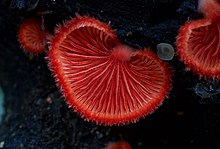Crepidotus cinnabarinus
| Crepidotus cinnabarinus | |
|---|---|

| |
| Crepidotus cinnabarinus | |
| Scientific classification | |
| Domain: | Eukaryota |
| Kingdom: | Fungi |
| Division: | Basidiomycota |
| Class: | Agaricomycetes |
| Order: | Agaricales |
| Family: | Crepidotaceae |
| Genus: | Crepidotus |
| Species: | C. cinnabarinus
|
| Binomial name | |
| Crepidotus cinnabarinus | |
| Synonyms | |
|
Crepidotus decurrens [2] | |
Crepidotus cinnabarinus is a species of saprophytic fungus in the family Crepidotaceae with a stipeless sessile cap distributed in North America and Europe.[3] It is highly conspicuous and often found on fallen branches and rotting trunks of broad leafed trees. In England it appears from late summer to autumn.[4]
Description[edit]
- Cap: Bright orangish red, the cap (pileus) of C. cinnabarinus is generally about 2 to 18mm in diameter and is convex, shell or fan shaped with a finely down felted surface when fresh, especially at its base, becoming minutely pitted or more or less bald and dry. The margin is irregular to fibrous and initially inrolled.[5][4]
- Stipe (stem): Absent, but a pale, lateral pseudostem is sometimes present.[5]
- Gills: Coloured pale brown with a red-orange edge, are crowded and adnexed.[4]
- Spores: The spore print is buff. Spore shape is broadly elliptical to subspherical with a finely spiny to warty surface, measuring 8-8.5–8.5
- Absent features- No annulus (ring).
| Gills on hymenium | |
| Cap is convex | |
| Hymenium is adnexed | |
| Lacks a stipe | |
| Spore print is buff | |
| Ecology is saprotrophic | |
| Edibility is inedible | |
References[edit]
Wikimedia Commons has media related to Crepidotus cinnabarinus.
- ^ Peck, C. H. 1895. New species of fungi. Bull. Torrey Bot. Club. 22:485-493
- ^ Crepidotus cinnabarinus in MycoBank.
- ^ "Cortinarius cinnabarinus . Fr". Discover Life. Retrieved 2022-06-21.
- ^ a b c d Buczacki, Stefan; Shields, Chris; Ovenden, Denys (2012). "Crepidotus cinnabarinus". Collins Fungi Guide. London: Harper Collins. ISBN 9780007466481.
- ^ a b "Crepidotus cinnabarinus". Mushroom expert. Retrieved 2022-06-21.
